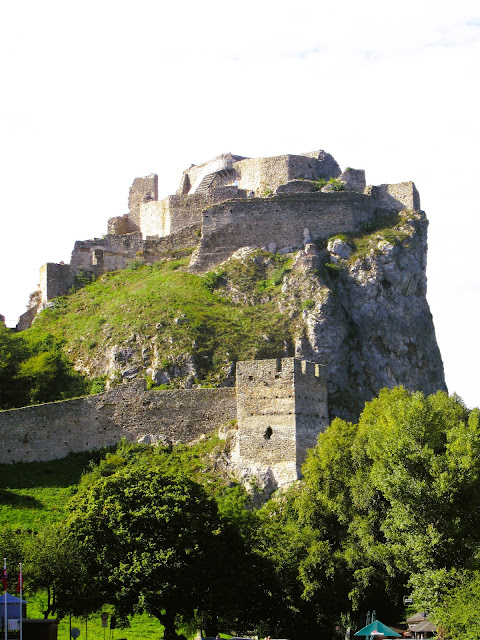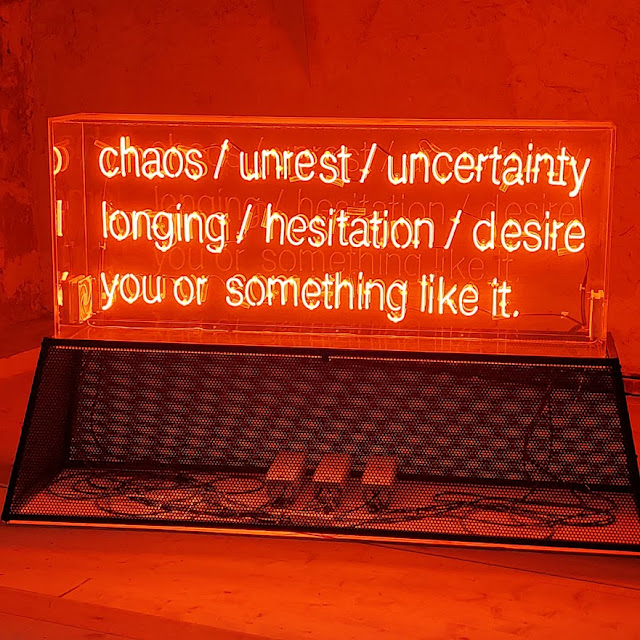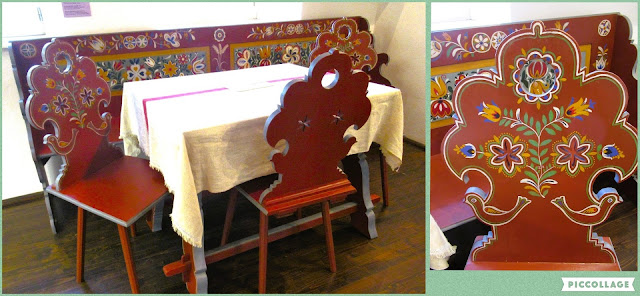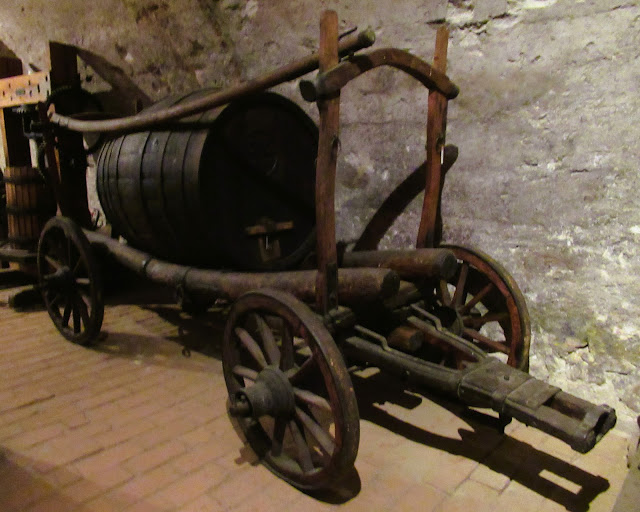An easy bus ride brings us from Vienna to Bratislava. We are told to get off at the Most (bridge) SNP bus stop and not go to the station. The advice that we couldn't miss the stop was accurate.
This engineering wonder is a member of the World Federation of Great Towers. For those who love physics, there's lots of information about its construction on the internet.
The bridge has had many names over the years (such as the UFO bridge, or Novy Most for New Bridge) but was built to honour a 1944 resistance movement against the Nazi forces. Most SNP = Bridge of the Slovak National Uprising.
A wall mural under the bridge depicts the events of the uprising.
The 'saucer' part of the bridge is a restaurant, sought out for its expansive views. We know that the restaurant is out of our price range and have decided that the trip up to the observation deck and viewing platform is too. We will head to Bratislava Castle and Devin Castle to have some splendid views.
Because the plan is to head to Budapest after Bratislava we will enter and leave Slovakia twice.
Research says that in Slovakia and Hungary it's less expensive to rent apartments than to stay in other types of accommodation and we find it to be true. The apartments are large and roomy with well-equipped kitchens and are centrally located. Here's our beautiful apartment in Bratislava in the heart of the old town. It even has a desk for working on the blog. It costs less to stay here per night than in our last hostels.
There are a couple of little bistros right outside our door in case we don't feel like cooking. During the daytime, the hum of gentle conversation drifts up to the apartment, but it's quiet at night. And on the other side of the street is a Jazz bar. We like it so much that an extra two days are booked.
We arrive on the last night of an annual event called White Night so hordes of tourists are in town.
 |
| SOURCE: Welcome to Bratislava website |
These large kaleidoscopic images in a dark square with electronic music in the background seemed to particularly attract children.
A huge Matryoshka doll (with the encouragement of children) is about to rise in this square.
 |
| Clock Tower old Town Hall - now a museum |
Rather than walk the street all night we're off to the jazz club. The woman is an amazing guitar player with an incredible voice. She sings mostly in English. Her partner's trombone is an unexpectedly perfect complement.
We returned to this little jazz bar on our last night in town but there's been an error and the band was double-booked. We go in anyway and sit at the bar with the bartender and his friend who is a musician and promoter and pass the evening in conversation and quiet canned jazz in the background.
On the second day we are set to wander Old Town to see if there are remnants of the art installations from the night before, but true to word, there are not. There are a couple of interesting pieces just outside of Old Town, but we don't know if they are a part of White Night or have been around for a while.
This interesting environmental piece down by the river documents the damage that fossil fuel extraction is doing in the north (of Russia, Canada, Norway, and others) to the environment, the indigenous peoples, and the permafrost. I don't know the name of the activist/researcher who did the piece. It seems like work from various photographers was incorporated. The words and the visuals are powerful.
It's easy to spot Cumil, Bratislava's famous sewer worker as there are lines of people who want their photo taken sitting by or on his head or lying on their stomachs in the street as if talking to him.
Both pedestrians and cars need to pay attention to signage to avoid stepping on or driving on top of his head, which the poor guy has lost more than once.
Cumil came about as someone's idea to lighten up the image of the city which has many communist-era statues. My favourite statue in town is of this young woman casually hanging out.
BRATISLAVA CASTLE (BRATISLAVSKY HRAD)
The hill on which this castle is located was first occupied by Celts in the Stone Age. Buildings have been built and torn down through the ages as borders changed and battles were won or lost.
We wind our way there right from Old Town.
 |
| Just a couple of several entry/exit gates |
 |
| The castle is built as a defensive square with a tower on each corner, a plaza in the center then gardens behind surrounded by high stone walls. |
VARIOUS VIEWS FROM BRATISLAVSKY HRAD
 |
| The spire of St. Martin's Cathedral |
It's only mid-September and although the weather is warm, many summer schedules have been cancelled. For example, we wanted to take a boat one way on the Danube to Hrad (Castle) Devin and a bus one way. The boat has been put to bed.
DEVIN CASTLE
The 212-meter cliff upon which Hrad Devin is perched looks down on the confluence of the Danube and Morava rivers, strategic in many ways. This section of the Danube was known as Amber Road. Pre-historic trade between northern and southern Europe was dependent on the trade of amber. Amber from the North and Baltic Sea ports was transported to ports on the Mediterranean Sea.
On a cloudless day from Devin Castle, one can see all the way to Vienna and to the 2,075-meter peak of Schneeberg, the highest mountain in Austria's Alps.
The approach to the castle is lovely. The partner groups who look after the property have decided that sheep and goats will maintain the grass.
Napoleon's troops blew the castle up in 1809, so these are the ruins of both the medieval castle and the ancient foundations on which it was built.
There's a small museum with samples of finds from archaeological excavations. Part of the exhibit is down in a cave in the castle rock.
An interesting find was what looked like a big round sour-dough bread-shaped lump of coal ... that was indeed a carbonized loaf of fermented bread dating from the 5th. century.
This castle was well worth the bus ride out to the community of Devin.
WALKABOUTS
Our favourite thing. Seeing what there is to see in different neighbourhoods. A lovely way to spend time on a sunny fall day is to walk the promenade, especially down by the docks where all the riverboats that ply the Danube tie up.
We can't seem to get to the Church of St. Elizabeth when it's open and during these irregular fall hours, many get to view only the outside. We do manage to get there on a cloudless day and the church seems to merge with a sky of the same colour. Everything is blue: from the blue-glazed roof to the blue mosaics and blue majolica. It really is pretty to see and draws your eye immediately. The inside is also painted blue.
A DOWSER WORKING HIS DIVINING ROD
 |
| Success!! |
THE NAVELS
Paul spots this interesting vehicle and soon the owners Greta and Jan come through the parking lot. They converted the old PUCH themselves and are getting ready to leave town. The parking attendant let them stay overnight for no charge as they have been able to do in many places. Amazing travelers. Here's the link to their blog
DAYTRIPPING: TRNAVA & PEZINOK
Trnava, 47 km NE of Bratislava with a population of ~70,000, on the Trnavka River is an easy and inexpensive train ride from Bratislava. As soon as we stepped into Old Town we thought this should have been an overnight trip.
This is one of the oldest and many say the prettiest, medieval towns in Slovakia. In the 13th. century it was granted 'Free Royal Town' status which meant that it could make its own independent decisions, free from the rule of the Royal family.
Trnava was granted the right to build fortifying walls and much of these remain intact today.
When we leave the protective walls of the old town there is a lovely river promenade to stroll with green space, statues, and resting areas.
In the 17th. and 18th. centuries the university attracted architects, master builders, sculptors and painters, whose influence is still felt today. I couldn't find an exact count of how many churches and cathedrals are in town, but there are many. Tour guides specialize in touring just the churches. Because of all the churches, Trnava is sometimes called "Little Rome".
Between the bus station and the Old Town is a folk-art ceramic shop that I wanted to visit. We arrived and the shop was closed. The owner obviously lives upstairs and invites visitors to ring her home bell. Knowing we cannot backpack ceramics I have to content myself with peering through the window.
Two former places of worship have been converted to other uses since the holocaust and the Jews of Trnava were either executed or fled.
Synagogue - Center of Contemporary Art, Jan Koniarek Gallery
We seek out this Art Gallery in a former synagogue. The building is mostly open space to serve the gallery. It seems like there hasn't been any restoration or preservation done. Staff give all who enter an information sheet placing the Center in the context of the Jewish history in Trnava.
A Canadian photographer currently has an exhibition in one of the rooms.
The second exhibition called Sustainable Empathy combines the work of two artists. One from Hungary and one from Slovakia.
I have to say that very abstract contemporary art is above my head and here is no exception. I just try to expose myself and stay open to it.
Synagogue Cafe
On walking in, one can clearly see that it was a synagogue. Restoration work has been done to preserve some of the original Jewish murals, symbols, and other artifacts.
This place serves wonderful food by friendly staff. It is also a bar and sometimes there is live entertainment. Looking around it is full of people enjoying the food with friends and/or family and business meetings, all in a relaxed atmosphere. Rooms with glass walls have been portioned off down both long sides into more private spaces.
There are articles by Jewish writers praising the work and conservation that has been done in keeping the building alive, while others criticize the lack of a memorial and education about what happened to the Jewish population of Trnava. Others say that only kosher food should be served there.
We enjoyed our time in the cafe and ate some of the freshest bagels of our lives.
Time to explore the heart of Trnava. A wide promenade (and these characters) welcomes you all through the center of Old Town.
At the far end, the lovely old clock tower (now a museum) that seems to be perpetually smiling greets onlookers. Later in the day when the sun warms the air, we climb the steps to look at the museum, see the workings of the clock and look down on the town from all angles.
It's a bit of a steep climb up the 143 steps to the viewing platform of the tower.
Its hard to pull ourselves away from Trnava but we are also excited to see Pezinok on the way back to Bratislava.
PEZINOK
This town of just under 25,000 people is at the foot of the Male Karpaty (Small Carpathians), which it turns out has perfect soil and growing conditions for the making of wine. In 1647 Pezinok could take charge of its future when King Ferdinand III granted it the privileges of a free royal town. Throughout the centuries Pezinok experienced both boom and bust and today is doing well with both the tourism and wine industries. It has numerous festivals every year and is paying attention to its cultural heritage. It would have been easy to spend a night here too. There are numerous hiking trails in the area.
We headed for the Small Carpathian Museum, home to one of Europe's most extensive collections of wine presses.
The museum is in a 17th. venture house in a burgher's vineyard and is in three main sections. Outdoors are some of the largest of the ancient wine presses. On the main floor of the building, a museum with many interactive displays about winemaking as well as traditional household items and finally in the wine cellar a collection of barrels, equipment used in viticulture, more presses, and a sample of delicious Pezinok wine awaits us at the end.
Presses
 |
| Presses often had elaborate carvings for decoration or to identify the family, year, etc. |

Presses from exceptionally large to very small.
 |
| The locksmiths of the day made this chest |
At the end of our visit to the museum, they seek our opinion, on a feedback form and we get to enjoy a glass of our choice of white or red wine while doing it. We both chose white and it's seriously good. Since then, we have searched for Pezinok wine in the stores. It's inexpensive and always tasty.
What a terrific museum.
RANDOM PHOTOS PEZINOK
 |
| At Pezinok Castle |
Back to Bratislava for our last day. We like the city and the people here a lot. Now it's off to Budapest, our only stop in Hungary.
A Few More Random Photos








































































































